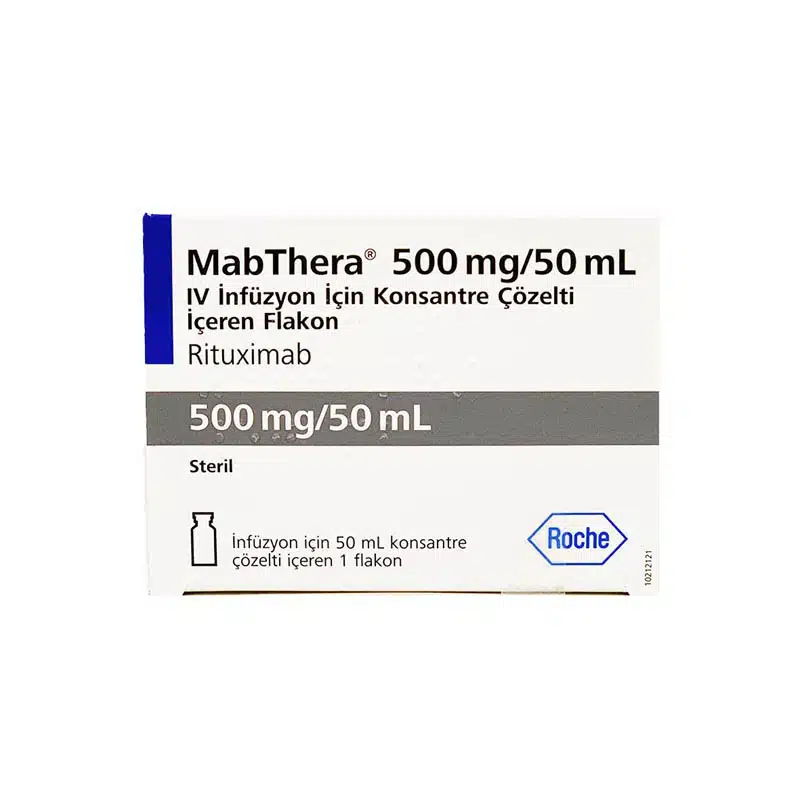MABTHERA® Indications for Use
MABTHERA® (rituximab) is indicated for the treatment of Non-Hodgkin’s Lymphoma (NHL), Chronic Lymphocytic Leukemia (CLL), and certain types of autoimmune diseases like Rheumatoid Arthritis (RA). Rituximab is a monoclonal antibody targeting the CD20 antigen found on B lymphocytes, making it effective for depleting B cells and treating these conditions.
Key Indications:
- Follicular NHL (stage III-IV) in combination with chemotherapy for patients previously untreated.
- Maintenance therapy for patients who respond to induction treatment for follicular lymphoma.
- Treatment of Diffuse Large B-cell Lymphoma (DLBCL) in combination with CHOP chemotherapy.
MABTHERA® Dosage Information
MABTHERA is available in intravenous (IV) and subcutaneous (SC) formulations. The subcutaneous version contains 1400 mg/11.7 ml of rituximab.
- Subcutaneous Dose: 1400 mg as a fixed dose for NHL.
- Intravenous Dose: Initial dose of 375 mg/m² for follicular NHL.
For Diffuse Large B-cell Lymphoma (DLBCL), the initial dose is 375 mg/m² intravenously followed by a fixed 1400 mg subcutaneous dose for subsequent cycles.
MABTHERA® Side Effects and Precautions
Patients receiving MABTHERA can experience various side effects, ranging from mild to severe. Common reactions involve infusion-related reactions that may include symptoms such as fever, chills, or rigors.
Common Side Effects:
- Redness, swelling, and pain at the injection site
- Fever and rigors
- Hypotension and hypertension
- Infections such as bacterial or viral
Severe Side Effects (less common but more critical):
- Cytokine Release Syndrome (CRS): A severe immune response to the drug, often seen within hours of administration.
- Tumor Lysis Syndrome (TLS): A condition caused by the rapid breakdown of tumor cells, which can result in kidney damage or failure.
- Progressive Multifocal Leukoencephalopathy (PML): A rare but severe brain infection linked to the John Cunningham (JC) virus.
Precautions:
- MABTHERA should be administered only by professionals experienced in cancer treatments, with full resuscitation equipment available.
- Patients receiving subcutaneous injections must first receive the IV formulation to check for tolerability.
MABTHERA® Clinical Studies or Real-World Outcomes
Rituximab has been widely studied and used in various clinical trials. The results demonstrate high efficacy in treating CD20-positive B-cell NHL and CLL, with significant patient response rates. MABTHERA is also effective in Rheumatoid Arthritis when combined with methotrexate.
Efficacy in Clinical Studies:
- Patients receiving MABTHERA for follicular lymphoma in combination with chemotherapy showed response rates of up to 84.4%.
- Complete Remission Rates (CRR) were reported to be around 32.2% in patients treated with the subcutaneous formulation.
Long-Term Results:
- 12 to 24 months of maintenance therapy in patients with follicular lymphoma significantly improved progression-free survival (PFS).
MABTHERA® Drug Interactions
MABTHERA may interact with other medications, particularly those affecting the immune system or the metabolism of rituximab.
Important Drug Interactions:
- Immunosuppressive Agents: Increased risk of infections when combined with other immunosuppressants, such as methotrexate.
- Chemotherapeutic Agents: MABTHERA can be combined with chemotherapy drugs like CHOP, but patients must be monitored closely for hematologic toxicity (e.g., neutropenia, thrombocytopenia).
Contraindications:
- Hypersensitivity to murine proteins or any of the components of MABTHERA.
- Active severe infections like sepsis or tuberculosis.
MABTHERA® Aftercare Instructions
Post-treatment care is essential for monitoring patients and mitigating potential side effects.
Post-Treatment Care:
- Patients should be monitored for at least 24 hours post-infusion for signs of infusion-related reactions.
- Hydration and frequent monitoring of renal function are critical, especially in patients at risk of tumor lysis syndrome.
What to Expect:
- Redness, swelling, or mild pain at the injection site can last for a few days after the subcutaneous injection.
- Fever, chills, or nausea can occur immediately after the infusion but typically resolve within 24–48 hours.
Follow-Up Treatments
Maintenance therapy may be recommended, particularly for patients with follicular lymphoma. MABTHERA is typically administered every two to three months for up to two years.
Long-Term Care:
- Regular monitoring of blood cell counts and immunoglobulin levels is necessary to detect potential immune suppression.
- For patients with hepatitis B, periodic screening for hepatitis reactivation is recommended during and after treatment.

